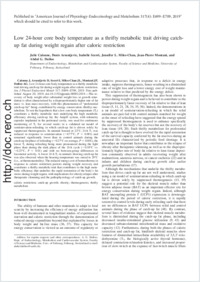Low 24-hour core body temperature as a thrifty metabolic trait driving catch-up fat during weight regain after caloric restriction
- Calonne, Julie Department of Endocrinology, Metabolism and Cardiovascular System, Faculty of Science and Medicine, University of Fribourg, Fribourg, Switzerland
- Arsenijevic, Denis Department of Endocrinology, Metabolism and Cardiovascular System, Faculty of Science and Medicine, University of Fribourg, Fribourg, Switzerland
- Scerri, Isabelle Department of Endocrinology, Metabolism and Cardiovascular System, Faculty of Science and Medicine, University of Fribourg, Fribourg, Switzerland
- Miles-Chan, Jennifer L. Department of Endocrinology, Metabolism and Cardiovascular System, Faculty of Science and Medicine, University of Fribourg, Fribourg, Switzerland
- Montani, Jean-Pierre Department of Endocrinology, Metabolism and Cardiovascular System, Faculty of Science and Medicine, University of Fribourg, Fribourg, Switzerland
- Dulloo, Abdul G. Department of Endocrinology, Metabolism and Cardiovascular System, Faculty of Science and Medicine, University of Fribourg, Fribourg, Switzerland
-
20.08.2019
Published in:
- American Journal of Physiology-Endocrinology and Metabolism. - 2019, vol. 317, no. 4, p. E699–E709
English
The recovery of body weight after substantial weight loss or growth retardation is often characterized by a disproportionately higher rate of fat mass vs. lean mass recovery, with this phenomenon of “preferential catch-up fat” being contributed by energy conservation (thrifty) metabolism. To test the hypothesis that a low core body temperature (Tc) constitutes a thrifty metabolic trait underlying the high metabolic efficiency driving catch-up fat, the Anipill system, with telemetry capsules implanted in the peritoneal cavity, was used for continuous monitoring of Tc for several weeks in a validated rat model of semistarvation-refeeding in which catch-up fat is driven solely by suppressed thermogenesis. In animals housed at 22°C, 24-h Tc was reduced in response to semistarvation (−0.77°C, P < 0.001) and remained significantly lower than in control animals during the catch-up fat phase of refeeding (−0.27°C on average, P < 0.001), the lower Tc during refeeding being more pronounced during the light phase than during the dark phase of the 24-h cycle (−0.30°C vs. −0.23°C, P < 0.01) and with no between-group differences in locomotor activity. A lower 24-h Tc in animals showing catch-up fat was also observed when the housing temperature was raised to 29°C (i.e., at thermoneutrality). The reduced energy cost of homeothermy in response to caloric restriction persists during weight recovery and constitutes a thrifty metabolic trait that contributes to the high metabolic efficiency that underlies the rapid restoration of the body’s fat stores during weight regain, with implications for obesity relapse after therapeutic slimming and the pathophysiology of catch-up growth.
- Faculty
- Faculté des sciences et de médecine
- Department
- Département de Médecine
- Language
-
- English
- Classification
- Biological sciences
- License
-
License undefined
- Identifiers
-
- RERO DOC 327407
- DOI 10.1152/ajpendo.00092.2019
- Persistent URL
- https://folia.unifr.ch/unifr/documents/308076
Statistics
Document views: 135
File downloads:
- pdf: 163
